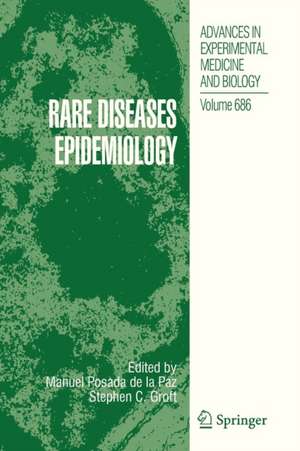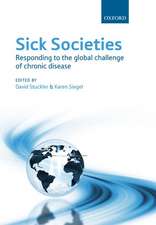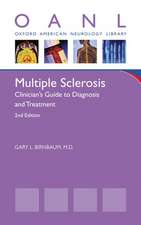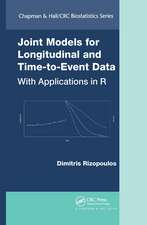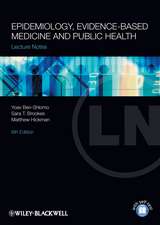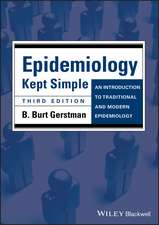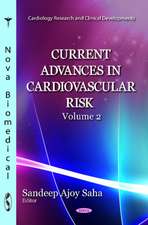Rare Diseases Epidemiology: Advances in Experimental Medicine and Biology, cartea 686
Editat de Manuel Posada de la Paz, Stephen C. Groften Limba Engleză Paperback – 7 noi 2012
Din seria Advances in Experimental Medicine and Biology
- 9%
 Preț: 719.60 lei
Preț: 719.60 lei - 20%
 Preț: 691.93 lei
Preț: 691.93 lei - 5%
 Preț: 717.00 lei
Preț: 717.00 lei - 5%
 Preț: 716.28 lei
Preț: 716.28 lei - 5%
 Preț: 717.20 lei
Preț: 717.20 lei - 15%
 Preț: 640.24 lei
Preț: 640.24 lei - 5%
 Preț: 1113.83 lei
Preț: 1113.83 lei - 5%
 Preț: 715.71 lei
Preț: 715.71 lei - 5%
 Preț: 820.43 lei
Preț: 820.43 lei - 15%
 Preț: 641.38 lei
Preț: 641.38 lei - 5%
 Preț: 716.28 lei
Preț: 716.28 lei - 5%
 Preț: 523.99 lei
Preț: 523.99 lei - 5%
 Preț: 1031.00 lei
Preț: 1031.00 lei - 5%
 Preț: 717.00 lei
Preț: 717.00 lei - 5%
 Preț: 715.35 lei
Preț: 715.35 lei - 20%
 Preț: 1161.71 lei
Preț: 1161.71 lei - 5%
 Preț: 1170.51 lei
Preț: 1170.51 lei - 18%
 Preț: 1119.87 lei
Preț: 1119.87 lei - 5%
 Preț: 1288.48 lei
Preț: 1288.48 lei - 5%
 Preț: 1164.67 lei
Preț: 1164.67 lei - 5%
 Preț: 1101.73 lei
Preț: 1101.73 lei - 18%
 Preț: 1123.67 lei
Preț: 1123.67 lei - 5%
 Preț: 1435.64 lei
Preț: 1435.64 lei - 20%
 Preț: 1044.10 lei
Preț: 1044.10 lei - 18%
 Preț: 946.39 lei
Preț: 946.39 lei - 5%
 Preț: 292.57 lei
Preț: 292.57 lei - 18%
 Preț: 957.62 lei
Preț: 957.62 lei - 18%
 Preț: 1235.76 lei
Preț: 1235.76 lei - 5%
 Preț: 1231.55 lei
Preț: 1231.55 lei - 5%
 Preț: 1292.30 lei
Preț: 1292.30 lei - 5%
 Preț: 1102.10 lei
Preț: 1102.10 lei - 18%
 Preț: 1132.81 lei
Preț: 1132.81 lei - 5%
 Preț: 1165.19 lei
Preț: 1165.19 lei - 5%
 Preț: 1418.48 lei
Preț: 1418.48 lei - 5%
 Preț: 1305.63 lei
Preț: 1305.63 lei - 18%
 Preț: 1417.72 lei
Preț: 1417.72 lei - 18%
 Preț: 1412.99 lei
Preț: 1412.99 lei - 24%
 Preț: 806.16 lei
Preț: 806.16 lei - 18%
 Preț: 1243.29 lei
Preț: 1243.29 lei - 5%
 Preț: 1429.44 lei
Preț: 1429.44 lei - 5%
 Preț: 1618.70 lei
Preț: 1618.70 lei - 5%
 Preț: 1305.12 lei
Preț: 1305.12 lei - 18%
 Preț: 1124.92 lei
Preț: 1124.92 lei - 5%
 Preț: 1097.54 lei
Preț: 1097.54 lei - 15%
 Preț: 649.87 lei
Preț: 649.87 lei - 5%
 Preț: 1097.54 lei
Preț: 1097.54 lei - 18%
 Preț: 945.79 lei
Preț: 945.79 lei - 5%
 Preț: 1123.16 lei
Preț: 1123.16 lei
Preț: 2072.23 lei
Preț vechi: 2181.29 lei
-5% Nou
Puncte Express: 3108
Preț estimativ în valută:
396.65€ • 430.99$ • 333.40£
396.65€ • 430.99$ • 333.40£
Carte tipărită la comandă
Livrare economică 16-22 aprilie
Preluare comenzi: 021 569.72.76
Specificații
ISBN-13: 9789400733381
ISBN-10: 9400733380
Pagini: 564
Dimensiuni: 155 x 235 x 30 mm
Greutate: 0.78 kg
Ediția:2010
Editura: SPRINGER NETHERLANDS
Colecția Springer
Seria Advances in Experimental Medicine and Biology
Locul publicării:Dordrecht, Netherlands
ISBN-10: 9400733380
Pagini: 564
Dimensiuni: 155 x 235 x 30 mm
Greutate: 0.78 kg
Ediția:2010
Editura: SPRINGER NETHERLANDS
Colecția Springer
Seria Advances in Experimental Medicine and Biology
Locul publicării:Dordrecht, Netherlands
Public țintă
Professional/practitionerDescriere
In
our
etiologic
research,
we
epidemiologists
need
to
leave
behind
the
concepts
of
‘cohort’
study
and
‘case–control’
study
and
adopt
that
of
the
etiologic
study
as
the
singular
substitute
for
these.
With
this
sentence,
the
famous
epidemiologist
Professor
Olli
S.
Miettinen
began
his
personal
re
ection
on
the
future
of
the
epidemiology
[1].
He
sought
to
highlight
the
fact
that
the
role
of
the
epidemiologist
should
be
mainly
focused
on
aetiological
research.
Nevertheless,
the
widespread
idea
still
exists
that
epidemiology
is
limited
to
purely
providing
gures
and
descriptive
data
on
the
frequency
and
distribution
of
disease.
Indeed,
it
is
more
than
likely
that
the
precise
aim
of
those
rst
classic
epidemiological
steps,
i.
e.
,
methods
essentially
based
on
describing
the
distri-
tion
of
a
given
disease,
is
still
not
all
that
well
understood
by
many
scientists,
let
alone
the
general
public.
Such
descriptions
seek
to
generate
hypotheses
and
afford
explanations
for
key
factors
(be
these
risk
factors
or
the
presumable
causes
th-
selves),
which
might
justify
differences
in
terms
of
persons,
time
or
place
and,
in
turn,
ultimately
serve
to
develop
preventive
measures
and/or
gain
quality-adjusted
life
years.
To
restrict
the
goals
of
epidemiology
to
activities
exclusively
concerned
with
reporting
gures
or
even
complex
statistical
results
is
a
great
mistake,
one
that
renders
it
dif
cult
to
take
full
advantage
of
the
epidemiologist’s
true
role,
which
is
“to
study
disease
determinants
and
to
assess
the
actual
impact
of
factors
involved
in
their
development,
distribution
and
dissemination”.
Cuprins
Rare
Diseases.-
Rare
Diseases
–
Avoiding
Misperceptions
and
Establishing
Realities:
The
Need
for
Reliable
Epidemiological
Data.-
Methods
and
Approaches.-
Rare
Diseases
Epidemiology
Research.-
Evidence-Based
Medicine
and
Rare
Diseases.-
Prevention,
Diagnosis
and
Services.-
The
Importance
of
Case
Reports
in
Advancing
Scientific
Knowledge
of
Rare
Diseases.-
Patient
Registries:
Utility,
Validity
and
Inference.-
Biobanking
in
Rare
Disorders.-
Evaluation
of
the
Validity
and
Utility
of
Genetic
Testing
for
Rare
Diseases.-
Population-Based
Surveillance
for
Rare
Congenital
and
Inherited
Disorders:
Models
and
Challenges.-
Statistical
Methods
for
the
Geographical
Analysis
of
Rare
Diseases.-
Clinical
Trials
and
Rare
Diseases.-
Pharmacoepidemiology.-
A
Regulatory
Overview
About
Rare
Diseases.-
Economics
and
Social
Epidemiology.-
Economic
Considerations
in
the
Provision
of
Treatments
for
Rare
Diseases.-
Rare
Diseases
Social
Epidemiology:
Analysis
of
Inequalities.-
Quality
of
Life
and
Rare
Diseases.-
Cost
of
Illness
and
Economic
Evaluation
in
Rare
Diseases.-
Epidemiology
of
Group
of
Rare
Diseases.-
The
Burden
of
Rare
Cancers
in
Europe.-
Hereditary
Channelopathies
in
Neurology.-
Osteochondral
Diseases
and
Fibrodysplasia
Ossificans
Progressiva.-
The
Prevalence
of
Congenital
Anomalies
in
Europe.-
Rare
Autoimmune
Diseases.-
Epidemiology
of
Rare
Anaemias
in
Europe.-
Inherited
Metabolic
Rare
Disease.-
The
Contribution
of
Rare
Diseases
to
Understanding
the
Epidemiology
of
Neurodevelopmental
Disabilities.-
Policy
and
Ethics
Issues
in
Rare
Diseases.-
Creating
a
European
Union
Framework
for
Actions
in
the
Field
of
Rare
Diseases.-
National
Plans
and
Strategies
on
Rare
Diseases
in
Europe.-
Ethical
Aspects
on
Rare
Diseases.-
Patient
Organizations
Role.-
Advocacy
Groups
and
Their
Role
in
Rare
Diseases
Research.
Recenzii
From
the
reviews:
“It covers the common components of epidemiology and its collaborating disciplines to demonstrate the concepts, methods, and examples of the epidemiology of rare diseases. … it is a useful resource for epidemiologists, the book can be used by other researchers and by funding agencies, foundations, and policy makers. … This is an important state-of-the-art book in rare disease epidemiology. … an extremely important contribution to the field and will be a useful reference in several disciplines.” (James C. Torner, Doody’s Review Service, July, 2011)
“The book is very well written, and deals with its subject delineated above comprehensively. … the amount of information presented is very impressive. The multitude of the data presented in the reviewed work make it indispensable for anyone potentially active in the field of the rare diseases … . this volume will remain the major reference book for quite some time, and highly recommend it to the healthcare planners, general practitioners and those specializing in the field of the rare diseases … .” (K. Pagava and I. Paghava, Georgian Medical News, Vol. 193 (4), 2011)
“It covers the common components of epidemiology and its collaborating disciplines to demonstrate the concepts, methods, and examples of the epidemiology of rare diseases. … it is a useful resource for epidemiologists, the book can be used by other researchers and by funding agencies, foundations, and policy makers. … This is an important state-of-the-art book in rare disease epidemiology. … an extremely important contribution to the field and will be a useful reference in several disciplines.” (James C. Torner, Doody’s Review Service, July, 2011)
“The book is very well written, and deals with its subject delineated above comprehensively. … the amount of information presented is very impressive. The multitude of the data presented in the reviewed work make it indispensable for anyone potentially active in the field of the rare diseases … . this volume will remain the major reference book for quite some time, and highly recommend it to the healthcare planners, general practitioners and those specializing in the field of the rare diseases … .” (K. Pagava and I. Paghava, Georgian Medical News, Vol. 193 (4), 2011)
Textul de pe ultima copertă
'Rare
Diseases
Epidemiology'
offers
numerous
approaches
to
increase
the
knowledge
base
of
rare
diseases
and
conditions
and
to
facilitate
the
development
and
dissemination
of
interventions
for
the
prevention,
diagnosis,
or
treatment
of
over
6500
diseases
and
conditions.
The
goals
of
epidemiology
are
not
restricted
merely
to
providing
numerical
data
on
the
prevalence
or
incidence
of
diseases
in
a
limited
or
general
population.
Analyses
of
epidemiological
data
gathered
from
appropriately
designed
and
conducted
studies
are
required
to
establish
public
health
policies
and
priorities
in
all
nations.
Information
gained
from
these
studies
lead
to
a
better
understanding
of
the
etiology
and
the
impact
of
genetic
or
environmental
factors
on
the
occurrence
and
outcome
of
these
disorders.
The
term
Rare
Diseases
includes
both
acquired
and
inherited
disorders.
'Rare
Diseases
Epidemiology'
provides
methods
and
approaches
from
the
collective
experiences
of
established
research
investigators
who
address
these
significant
issues
of
the
development
of
patient
registries;
the
collection,
storage
and
selected
distribution
of
bio-specimens
from
bio-banking
activities;
the
validation
and
utilization
of
genetic
testing
and
newborn
screening
procedures;
the
presentation
of
issues
related
to
the
importance
of
case
reports
to
increase
knowledge
of
rare
diseases;
the
challenges
and
models
for
population-based
surveillance
studies
for
rare
congenital
and
inherited
disorders;
the
statistical
methods
for
the
geographical
analyses
of
rare
diseases;
the
value
and
need
for
clinical
trials
and
comparative
effective
studies;
and
meeting
the
requirements
of
regulatory
agencies.
Economic,
societal,
and
ethical
concerns
are
presented
as
patients
and
families
encounter
difficulties
obtaining
the
correct
diagnosis,
gaining
access
to
treatments,
and
receiving
coverage
or
reimbursement
for
approved
interventions,
and
for
developing
a
public
understanding
of
the
costs
to
patients
and
their
families
and
the
burden
of
illness
affecting
the
quality
of
life
of
millions
of
patients
with
rare
diseases
and
conditions.
Framework
programs
for
rare
diseases
research
as
developed
by
the
European
Union
and
the
value
of
national
plans
for
individual
member
countries
are
discussed
and
represent
the
public
commitment
to
patients
with
rare
diseases.
Likewise,
similar
programs
have
been
implemented
in
the
USA
as
a
result
of
the
Orphan
Drug
Act
to
address
the
needs
of
the
rare
diseases
community.
Caracteristici
It
is
the
first
book
edited
on
Rare
Diseases
Epidemiology
Develops
a
comprehensive
approach
to
the
rare
diseases
epidemiological
problems
Teach
the
best
knowledge
currently
available
Opens
future
perspectives
for
health
planning
and
decision
making
Provides
a
general
framework
for
physicians,
public
health
experts
and
basic
researchers
